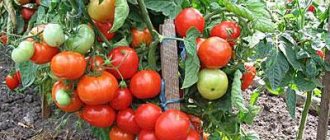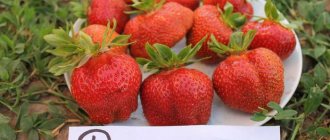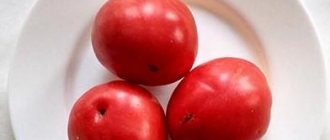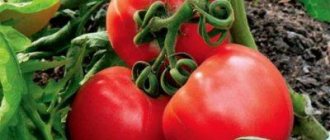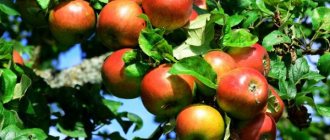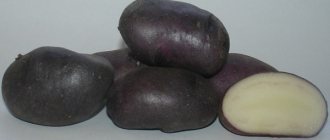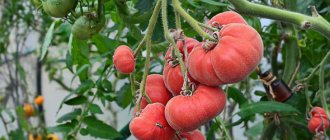Characteristics and description of the variety
Externally, the tree is medium-sized, up to 3 m in height, with a dense and spreading spherical crown. The bark is thick and brown. The foliage is large, with a carved edge. Frost resistance is good: trees can tolerate temperatures down to –33°C. As for flower buds, they are not afraid of frosts down to –2°C. The tree begins to bear fruit at the age of 4-5 years. The fruits ripen in mid-August.
The shape of apricots is egg-shaped, slightly flattened , weight - up to 52 g. They are covered with a dense yellow peel with a slight blush. The pulp is the same color, has a delicate structure, the stone is easily separated. The taste is sweet and sour with a pleasant light aroma.
Red-cheeked
Red-cheeked is a mid-season variety. The tree grows to a medium size, with a spreading, rounded crown. The fruits ripen round or ovoid, their skin is pubescent, golden-orange with a slight reddish blush. The pulp is very tasty, sweet and sour, aromatic.
The advantage of this variety is also that the tree begins to bear fruit 3-4 years after planting the seedling.
| Purpose | Harvest | Tree height (m) | Fruit weight (g) | Productivity (kg per tree) |
| 2nd half July | 4-5 | 40-60 | up to 90 | |
Features of apricot planting
The variety is classified as undemanding in relation to growing conditions. Loose and fertile soil is ideal for planting it. It is important to choose an area with deep groundwater - at a level of 3-4 m, since apricot does not tolerate waterlogged soil.
Selection of seedlings for planting
In order for the tree to quickly take root, you need to carefully inspect it at the time of purchase.
First of all, you should pay attention to the following factors:
- Condition of the root collar . Above the rhizome there should be a slight bend with a round healed wound - the place after the cut rootstock.
- External view of the trunk . In a healthy seedling, it is even and smooth, without any damage or signs of fungal attack.
- Rhizome . Small branches should be lush and dense, and the root itself should be well developed, without damage.
- Terms of sale. In order to protect the root system from drying out and dying, it is wrapped in a damp cloth, covered with moistened sawdust, etc.
- Tree age . Young plants, up to 2 years old, take root best.
Preparation of planting material
Planting is done in the spring - before the buds open, or in the fall - 4 weeks before the onset of frost. The planting hole is prepared in advance so that the soil settles to the desired level : this will take several weeks. For an apricot seedling, you need a hole measuring 70x80 cm and 60 cm deep. Drainage is placed at its bottom - broken bricks or crushed stone.
Then add a nutrient mixture, which includes:
- 3 parts humus;
- 1 part superphosphate;
- 0.5 parts potassium chloride.
After this, a mound is formed from the excavated soil, which will protect the roots from chemical burns.
Before planting, the seedling is inspected for damaged and dead roots, which must be removed using pruning shears. The base of the barrel is wiped with a damp cloth.
To treat the root system, prepare the following solution:
- 1 part clay;
- 2 parts mullein;
- 5 parts water.
The rhizome is dipped into it immediately before planting. The procedure will nourish the tree and also speed up the process of its adaptation.
Direct landing
Having completed all the preparatory work, they begin the planting itself, which is carried out according to the following scheme:
- Planting material is placed in a hole and the roots are straightened. The root collar should be 3 cm above ground level.
- A support is installed on the south side - a wooden stake.
- The hole is filled with earth, lightly compacting it.
- The seedling is watered using about 2-3 buckets of water.
- The tree trunk circle is sprinkled with sawdust.
- The tree is tied to a support.
Video: Instructions for planting apricots
Forum statistics
208686 Messages in 1636 Topics from 5641 Users. Last user: Cerberus Last message: “Rooting wine cuttings...” ( Today at 06:57:45) Latest messages on the forum.
Now on the forum
42 Guests, 13 Users
Users in the last 15 minutes: Elvira2017, zsb, Vova Kapran, Natasha, yotmast, Alexander Vl., DIL, Lyubov S., YurSanych, Evgeniy 50, Nikolai Mikhailovich, Alexander K, vlad51 [Blocked] [Section Moderator] [Forum Moderator]
Maximum online today: 112 . All-time maximum online: 2758 (28 July 2021, 17:22:51)
Users who visited the forum in the last 24 hours
Total: 320
(Visible: 319, Hidden: 1) 1963, zsb, Vova Kapran, Elvira2017, yotmast, Alexander Vl., Natasha, DIL, Lyubov S., YurSanych, Capricorn, Evgeniy 50, Nikolai Mikhailovich, Alexander K, vlad51, GALINA ANOKHINA, Andrey 31, Evgeny 163, Evgen_ev, Tatyana Korova, Scythian, Casperzrq, Leonidych, Victor B, Nikolai Lipunov, Sergei, Evgeniy52, 77volt, Hanter64, Tatyana B, Kosmos, Slavalimon, Mikhail77, Skiier, Rivan, Y_FED, KAZ. AK, Igor Sergeevich , Victor55, Andrey15, OlgaOs, Ilya 77, DorontsovPeter, Chapai, Buba, Mikhno Alexander, dralexk1, alexsandr, Amber7394, SANYCH, Pioneer, DimaRostov, Dmitry 77, Verona, DED2, MaxL, nicson7, Vasily V., Kenig, Alexander Taganrog , VitalySD, Dmitry-Kozadoev, Realist, Alexey Deminov, Elektronik_t, Galinka, DSW, Alexey Agryzkov, Taker, Kadyrov, bonami, antar, Sergey 1965, Andrey Gladilin, SvetlanaBondareva, tolya, Nadezhda Grig, Igor Naumov, Igor F., kvg , Pavel 64, Volgar, Roman Fedorovich, igor222, max2008-01, Iv Iv, Vika, Andrey Lis, Evgeniy30, lomakin1969, linalenadavi, gheo55, Sergey Chistokletov, mystic69, Grinya, Cherkessk, Andrey76, Serzh1978, Haus, , Vladimir-kanevskaya , Iglika, Marina Protasova, Mikhail Alekseevich, Linx, Morgana, Igor K, Tatyana Rogacheva, Ekaterina Polyanina, Yuri _Saransk, Sergey 61, Armagnac, Alexander48, tsv, Verbitsky E.I., Lyudmila, Victoria Aleksandrovna, Vladimir Berdnikov, vladimirM, and.drew, Maximilian, Denisovich, Yura Soshnin, Tikhii, Elena Z, Sasha57, Natalia Nikolaevna, Yuri Gaivoronsky, Oleg56, weather forecaster, ElenkaF, Lydia58, Vyacheslav03, Sa-shura, irahelm, Pitko, Volodya R, Volgogradka, Alexander71, Natalya1968 , Valentina Ivanovna, freesia, L.A.P., Lyuda5, Alexey V, dayton, marlin64, Tanyusha, Vasily1111, Yuri 14, Dmitry Nikolaevich, Oleg Filippov, Valery Rastorguev, Kalevanych, AlexsandrP, LeXa_KoT, Sergey Yuryev, Inna161, cfibr , stenlly2010, rambo, maxbul, Nadymchanka, Ivan Levin, Eduard., nik2, serginio, potap05, nadia, VeraNiK, Sergey Tashchiyan, G.V., Amateur gardener, Alexander-ask-34, Vladimir Kostochkin, Wintel, Vyacheslav Vladimirovich, mers, Izhitsa, Ramiz, Ahmed, gardener, P7N, alexss, Zaur, TITOVA LYUBOV, Sergey Ko, Tatyana Volzh, Grandfather Young, pioneer-2, ketch, Bublichenko Alexander M, Ildar, Sergei Vasilevi4, Oleg Ivanovich delivered, Helga, Marshal , Vasily 53, Den, Alexander150, Yavgen3678, vikbublik, Valerie, Henry, Alexander_89, nick041, Svetlana Streletskaya, Antrikan, neposny, yak, 25nata35, Vladimir Buturlakin, Yagodka, Aprel, Antonk1983, PS-URA, spotlight, Nikolay S., Andrey68, Alexander565, Gennady163, AndSanych, Alexander Gay, Alex65, kdm57, oleg9f, Svetlana Korotina, Dmitry Badaev, Belgorodets, Yura, formula1, Cerberus, 64nikolay64, Yuri Semyonov, Kryn, N.A. Sokolov, TIS, Guram, sem_en, Alexander Smirnov, AlexanderD, Spikina Galina, Anatoly Sivkov, Snezhinets, Alexey Sh., mira567, Mst, victor_, Vadim, Salex, Yuri P., Bison, thanatos, Alexander Sh, Vardan, cecet71, Coltrane, Alexander 61, Andrey Beribesov, Efimych, boltik, Vladimir-27, Vovka, LOZA, ilja, Unter, Gela, Irinka, NatalyaMed, ichtiandr, Sergey Lomonosov, krasnovlad1, Irene, Pirko Alexander, Khramov, YATATYANA, , Vitaly Kholkin, Mihalych., ni, Vladimir Kovba, Rita, nau_63, Yuri72, Lisav, niy1, Timofey, NelyaS, MikhAf, Alexander Zinoviev, Zayac, SNovichek, Tatyana A., VDV, Dmitry-Ivanovich, Saisan, slaviking, court, Vladimir Shilov, Oleg Swedov, Sergey2017, Masha_sadovod, Burundukx , Lamo, Oleg A., arnyusha, Leonty Yarygin, Vyacheslav-56, lena, Igor 31, Sergey 31, Zhorzhovich, nut lover, Enych, turist, Ewgeniy, Ivan Shmelev, atseton, Liza
Harvest and storage
The crop is harvested at the moment it reaches technical ripeness, when the fruits have acquired the characteristic color of the variety and the pulp is still dense. Sardonyx apricots will ripen in the first half of August. The fruits are removed by hand, carefully separated from the stalk, after which they are placed in a plastic container, and the layers are covered with parchment.
For storage, the containers are transferred to a place with a temperature of +20. +23°C, where the fruits can remain for about 2–3 days. To preserve apricots for as long as possible, indicators at level +10 are required. +15°С. In the refrigerator, the product does not lose its taste for 4 weeks. Today there is a wide variety of apricots. They can be grown in different climatic zones, while obtaining a rich harvest and high taste of the fruit. By following the above basic rules, you can grow the Sardonyx apricot variety in your backyard.
What varieties are there according to ripening time?
Depending on the period of fruit ripening, all apricots are divided into early-ripening, mid-ripening and late-ripening. The first is the Alyosha variety. Also good reviews about the apricot Zhigulevsky Souvenir, June. Among the mid-season varieties, Altair, Olympus, Aviator, Amursky, Phelps, and Aquarius are most often chosen. Having decided to plant a late variety of apricot, it makes sense to pay attention to apricots Hargrand, Sirena, Kostyuzhensky, Iskra. It is advisable to plant several types of fruit trees with different ripening periods. Then the summer resident will enjoy fresh aromatic fruits much longer.
Description of the variety
Gardeners do not hesitate to occupy planting areas with Sardonyx. It has excellent technical data. The description of the variety confirms this:
- apricot begins to bear fruit in the 4-5th year of life in the garden;
- medium-late variety (fruits ripen in mid-August);
- partial self-fertility (pollinating plants are required to obtain a good harvest);
- frost resistance of a tree is minus 33.7 degrees Celsius, of blossoming flowers - 2.8;
- medium-sized tree (up to 3 m tall);
- the crown is dense, spherical;
- bark brown, thick;
- the leaves are large, the edges are slightly serrated;
- flowers are white.
Sardonyx requires the presence of pollinators. Amber, Michurinsky Best, Champion of the North are suitable.
- maximum fetal weight 52 g;
- the shape of the apricot is ovoid, irregular;
- the skin is dense, strong;
- yellow apricot;
- the pulp is juicy, yellow;
- the taste is delicate, sweet and sour;
- the aroma is pleasant;
- The ripe fruit pit is easily separated.
A tree takes up a lot of space on a summer cottage: it is recommended to place trees at a distance of 5-6 m from each other.
Which self-fertile varieties are frost-resistant?
In the middle and northern regions, where the climate, and especially winters, are unpredictable, it is necessary to plant frost-resistant self-fertile apricot varieties.
- " Northern Triumph " grows up to 4 meters in height. It is characterized by increased frost resistance; it is grown even in the northern regions of Russia. The weight of the fruit reaches 60 g. The shape is oval, the color of the peel is yellow with pink spots on the surface, the pubescence is weak. The flesh of Northern Triumph is sweet and sour, juicy. Among the disadvantages, the average yield is noted - 50-60 kg, unstable fruiting, and also the fact that the first harvest can only be obtained in the 5th year of planting.
- “ Tsarsky ” is an early-ripening, self-fertile apricot variety. Frost resistance up to -40 degrees Celsius. The tree grows up to 4 meters, and the first fruits appear around the 4th year. Productivity per tree is up to 30 kg. Fruits are 20-30 g, yellow, with a red blush. The pulp is sweet and sour. Among the disadvantages, it should be noted that the fruits are small and that the stone is difficult to separate from the pulp.
- " Sardonyx " is a mid-season variety. Withstands frosts down to -33.7 degrees Celsius. Fruit ripening is observed in early August. The tree is of medium height, early-bearing, the first harvest is harvested 4 years after planting. The weight of the oval fruits is up to 50 g, the peel is orange, the flesh is lighter. The taste is sweet, the fruits have universal uses.
- “ Hardy ” is a late self-fertile apricot variety. Gives consistently high yields. The tree is tall, vigorous, the crown is slightly branched, and needs shaping. Bears fruit from 5-6 years, yield up to 60 kg/tree. Winter hardiness is increased, there is average resistance to disease. But it is worth considering that the variety is often affected by moniliosis, and therefore requires regular treatment. Apricots weigh between 30-40 g, round and flattened on both sides. The peel is yellow-orange, dense, the pubescence is weak. The taste is sweet, rich, sugary.
Apricot varieties for the Moscow region are famous for their good winter hardiness.
Features of cultivation
To obtain an annual stable harvest of delicious fruits, you must follow the growing rules.
Soil selection
Sardonyx is not capricious. But it requires loose, fertile soil with a neutral or slightly alkaline reaction. On acidic soils, it is recommended to carry out liming before planting. Heavy clay soils should be sanded (a bucket of coarse sand per 1 square meter should be added for digging).
It is necessary to prepare the landing hole in advance. Its size: 70 cm x 70 cm x 70 cm. The soil is removed and neatly folded next to the hole. It is then mixed with mature organic matter and mineral complex and returned to its place. It is recommended to prepare the hole in the spring for planned autumn planting and in the fall for spring planting.
It is important to consider the depth of groundwater: Sardonyx does not tolerate waterlogging in the root area. Groundwater should be deeper than 3-4 m from the soil surface.
Optimal planting period
The young tree must take root properly before the onset of winter. This is the only way he will be able to survive the unfavorable time.
Sardonyx should be planted in early spring (before buds open) or autumn (in the first half of September, 3-4 weeks before the onset of steady cold).
If the gardener cannot immediately plant the purchased seedling in a permanent place, the tree should be buried in a trench. This way the apricot will wait until the time of placement without harm to itself.
Growing technology
Sardonyx requires compliance with growing technology. Only in this case will the gardener receive a good harvest.
Watering
An adult Sardonyx provides itself with water. It is recommended to water it only during prolonged drought. Young seedlings require regular moisture (once every two weeks).
Watering should be stopped 2-3 weeks before the fruits ripen: excessive moisture will spoil the taste of apricots.
Trimming
Sardonyx is prone to overgrowing. Excess shoots need to be trimmed. Formative pruning needs to be done regularly. The optimal time is early spring or late autumn. The sap flow stopped at this time. The tree will survive the operation painlessly. Trimming rules:
- the crown should be transparent;
- all dried and damaged (during snowfall or wind) shoots are removed;
- branches growing at an acute angle or crossing are cut out;
- cuts are made “on the ring” (to avoid rot);
- wounds larger than 1.5 cm are covered with garden varnish or oil paint (to protect against bacteria and fungi).
For pruning, use a disinfected (with alcohol or potassium permanganate) and well-sharpened tool..
Top dressing
Sardonyx is responsive to fertilization. It is recommended to apply mineral complexes in spring and autumn. Mature organic matter - only in spring. Compost and humus are poured out around the tree trunk. The earth is then loosened.
Reproduction
Gardeners often strive to propagate the variety. This can be done through vaccination. An apricot with different characteristics grows from the seed. It can be used as a rootstock. And the scion should be taken from an adult Sardonyx tree.
Diseases and pests
Sardonyx has a weak immune system. To protect against pests, it is recommended to carry out preventive treatments with insecticides. If signs of pest damage appear, insecticides should be applied.
Spraying with copper-containing preparations will help protect the variety from diseases. Excellent results are achieved by preventative measures: removal of plant residues, timely weeding.
Description and characteristics of the variety
Apricot trees "Sardonyx" are of medium vigor, with a dense and spreading crown. A characteristic feature is the excellent winter hardiness of not only wood, but also flower buds. The frost resistance of adult plants is at least -33.3-33.7°C, and the frost resistance of flowers and flower buds is -2.8°C.
The harvest ripens in early August. Apricot trees enter the fruiting phase in the fourth or fifth year. The variety belongs to the category of partially self-fertile, so gardeners need to take care in advance of planting apricot seedlings on the site with similar flowering and fruiting periods.
The fruits are large in size, ovoid or flattened. The average weight of an apricot reaches 48-52 g. The pulp of a ripe fruit is yellow in color, dense in consistency, very tender, with a pleasant aroma and good taste. The stone at the stage of full ripening is easily separated from the pulp. The taste of the fruit on a five-point tasting scale is rated at 4.23-4.28 points.
Which apricot varieties are resistant to moniliosis?
In addition, the process becomes more difficult in rainy weather. Therefore, gardeners often plant moniliosis-resistant apricot varieties on their plots.
These varieties include:
- Denisyuk's special.
- Monastic.
- Goldrich.
Apricot Special Denisyuk
Today there are many varieties known that are immune to moniliosis. The most sought after is Denisyuk's Special. Late ripening variety. The tree is medium-sized. The crown is not particularly thick. Productivity and winter hardiness are high. The fruits are characterized by an unusual carmine color. Large in size. The pulp is of good taste and juicy. Ripe fruits are capable of not falling from the branches for a long period.
Apricot Monastyrsky
A medium ripening variety. The plant is not tall. The crown is rounded. Winter hardiness and yield are good. The fruits are quite large. They have a yellow-orange color. There is no blush. Monastyrsky is distinguished by its unsurpassed aroma and excellent taste. For which domestic gardeners are very fond of it.
Apricot Goldrich
The plant is medium-sized. The crown is decomposed and wide. Goldrich is characterized by productivity, winter hardiness, immunity to moniliosis and sharka. At the moment this is the largest-fruited variety. The weight of apricot reaches 90 grams. There are specimens weighing more than 100 grams. The shape of the fruit is oval, slightly flattened on the sides. The skin is orange with a slight red blush. The pulp is dense, dark orange. The aroma is light and pleasant.
Planting seedlings in spring and autumn
Apricot seedlings of the domestic variety “Sardonyx” can be planted in spring and autumn. The preferred option is to plant in the spring according to the following technology:
- Planting holes for spring planting should be prepared in the fall;
- the optimal dimensions of planting holes are approximately 70 x 80 cm with a depth of at least 60 cm;
- a layer of drainage in the form of broken bricks, branches or crushed stone should be poured into the bottom of the planting hole, and then sprinkled with a loose soil mixture of wood ash, humus and fertile topsoil;
- the standard distance between planting holes for apricots should not be less than three meters, which will provide fruit trees with optimal area for the development and nutrition of the root system;
- The roots of apricot seedlings should be carefully straightened and sprinkled with pre-prepared chernozem, which is lightly compacted around the plant stem.
After planting, each plant must be watered with plenty of water, at the rate of a couple of buckets per apricot seedling. If necessary, soil is added to the tree trunk circles and then mulched with sawdust.
For planting in the autumn, preparation of planting holes is carried out at least a couple of weeks before the expected date of work, which will allow the soil to settle to the desired level.
Prevention of diseases and pests
For the Sardonyx apricot, proper preventive treatment is very important, allowing the fruit tree to remain not only healthy, but also very productive for a long time:
- before the buds open, the tree bark is protected from sunburn, and measures are also taken to destroy overwintered insect pests and fungal diseases developing under the bark;
- dried branches are pruned, necrotic areas on the bark are cleared to healthy tissue, and open wounds or cuts are subsequently disinfected with a 1% solution of copper sulfate with garden varnish;
- before the flowering stage and after flowering, plants are sprayed with colloidal sulfur at a temperature of 18°C and above or with the drug “Neoron”, which has good effectiveness both at low and high temperature conditions;
- During the period of fruit growth and development, it is necessary to treat sucking and leaf-eating pests with Decis, Fufanon, Kemifos, Iskra, Tsitkor, Kinmiks or Fury, as well as spray the plants with colloidal sulfur.
After harvesting, you should remove and burn fallen leaves and rotten fruits, and if necessary, spray the garden plantings with insectofungicides and whitewash the trunk and the forked part of the skeletal branches.
Apricots in Siberia: varieties (video)
According to experienced gardeners, the most convenient and productive is the crown formed during pruning in a cup-shaped or tieless type. The excellent winter hardiness of mature trees reduces the need to insulate fruit trees. The description of the variety and its characteristics make it possible to classify the “Sardoniks” apricot as one of the most promising varieties for growing in home gardening conditions.
Sources:
https://fermer.blog/bok/sad/plodovye-derevya/abrikos/sorta-abrikosa/srednepozdnie-sorta-abrikosa/7943-abrikos-sardoniks.html https://dachamechty.ru/abrikos/sardoniks.html https: //dachadecor.ru/derevya/abrikos-sardoniks-opisanie-i-technologiya-viraschivaniya-otechestvennogo-sorta
